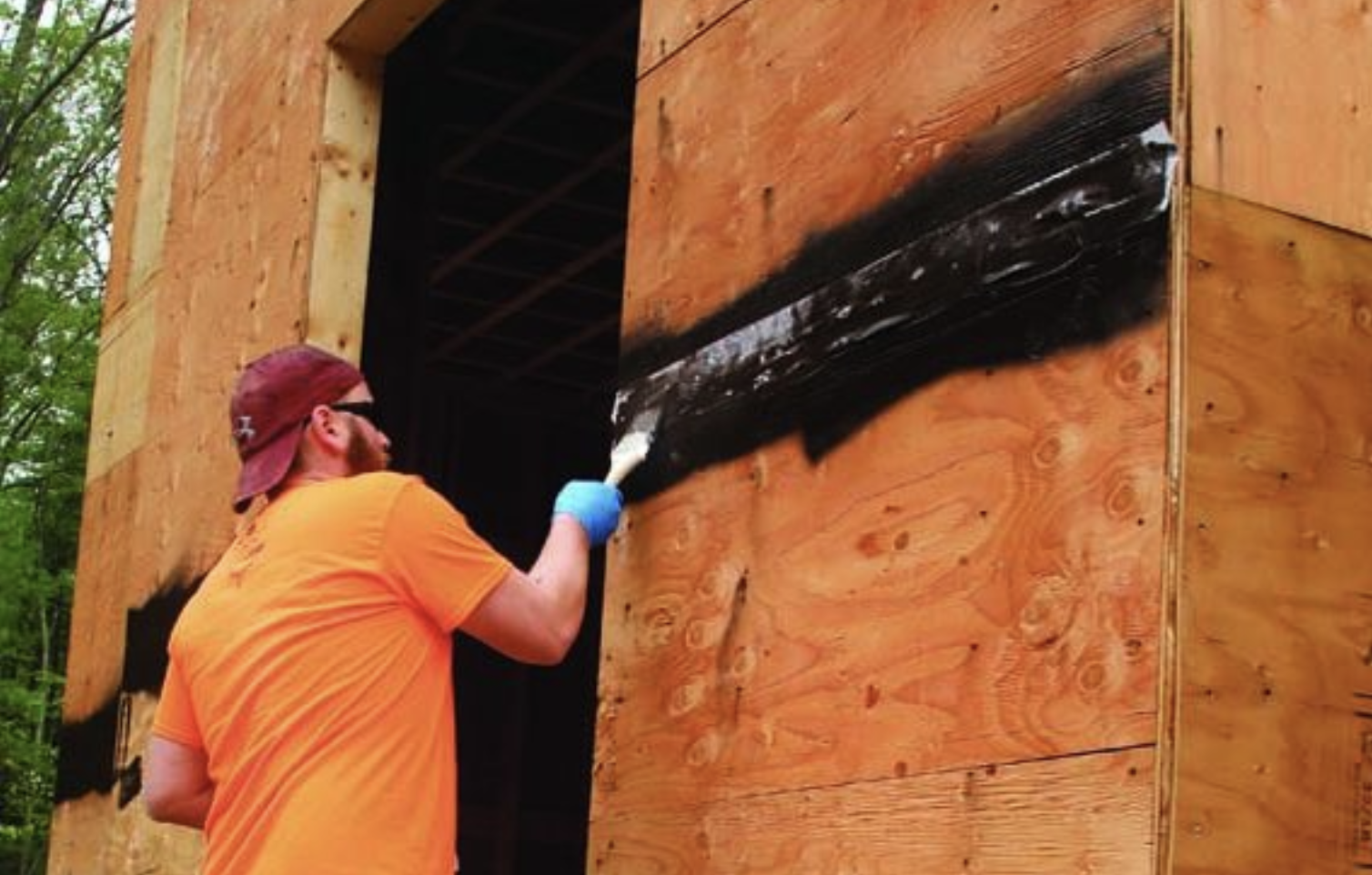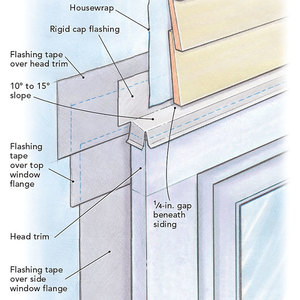
Image Credit: Image #1: Huber Engineered Woods
By now, most conscientious builders know that window rough openings need to be carefully flashed before a window is installed. For residential builders, the most common way, by far, to flash window rough openings is with peel-and-stick flashing.
However, an increasing number of builders are taking a closer look at something different: liquid-applied flashing.
What is liquid-applied flashing?
Liquid-applied flashing comes in various forms. Some products are dispensed from cartridges like caulk; others come in a pail and have the consistency of mayonnaise.
If you are using liquid-applied flashing to flash a window rough opening, you squeeze or spread a generous amount on the surfaces that need flashing — generally the rough sill, the rough jambs, the head, and a 6 to 8 inch wide band of the wall sheathing around the perimeter of the rough opening — and then you spread the material out with a trowel or a plastic Bondo spreading tool. (Some products have a thinner consistency that can be applied with a brush or roller.) Most manufacturers advise adding enough material to make an opaque layer — one that you can’t see through.
In addition to being useful for flashing window rough openings, liquid-applied flashings can be used to flash penetrations through wall sheathing — for example, vent pipes or plumbing pipes.
Liquid-applied flashings are stick tenaciously to a wide variety of materials. Most manufacturers of liquid-applied flashing claim that their products stick to plywood, OSB, framing lumber, concrete, CMUs, brick, aluminum, painted steel, vinyl, rigid foam, glass, and EPDM. (Note, however, that some manufacturers warn that their products don’t stick to housewrap.)
Most brands of liquid-applied flashing can bridge cracks up to 1/4 inch wide without the need for any caulk or reinforcing mesh. Once cured, these flashings form a rubbery layer that is vapor-permeable yet waterproof and airtight.
This…
Weekly Newsletter
Get building science and energy efficiency advice, plus special offers, in your inbox.

This article is only available to GBA Prime Members
Sign up for a free trial and get instant access to this article as well as GBA’s complete library of premium articles and construction details.
Start Free TrialAlready a member? Log in















23 Comments
liquid flashings
Martin - Thanks for an informative article. It seems as though the liquids are particularly well suited for corners of the rough openings. Does anyone use the peel and stick membranes for the openings and then the liquids for the corners? I have no experience with these liquid flashings, but it seems a combination these may be a good way to go, assuming they would be compatible. Or would that defeat the whole purpose of them?
Kevin.
For years we just used a butterfly in the corners of ROs. Now peel and sticks are flexible enough to bend round them. I'm not sure there is much left for the liquid membrane to do if you line the ROs with P&S.
Response to Kevin Zorski
Kevin,
One of the exciting promises of liquid-applied flashings is that these products can simplify flashing work. To achieve that promise, builders (ideally) need to choose a system with as few components as possible. Methods that require both peel-and-stick and liquid-applied flashing don't achieve the goal of simplifying the flashing process.
That's why I like the "Zip sheathing as WRB + liquid flashing for window rough openings" approach.
Response to Kevin Dickson
Kevin,
It sounds like you are advocating the use of a liquid-applied WRB over the entire surface of the wall. I agree that it is a good system for those who can afford it.
I should point out, however, that most WRBs, including plastic housewrap and asphalt felt, allow builders to use CDX plywood. You are correct, of course, that a liquid-applied WRB provides a much better air barrier than Tyvek.
Air Barrier/WRB Two-for-One
I think it's a big deal to mention that these spray-on liquid applied membranes function as both the WRB and air barrier.
1. They look to be easily inspectable and repairable before the siding goes on.
2. You don't need staples or nails to hold it on. (Therefore fewer penetrations)
3. Allows the builder to use real CDX plywood, which is far more robust than OSB products.
4. Combined with 10+ inches of cellulose insulation in a double wall assembly, you have the simplest possible High R wall.
Embedded Transition strip
Martin,
Thanks for the great article. At Hammer and Hand we prefer to utilize fluid applied WRBs; however, we often pair fluid applied flashing at rough openings and penetrations with standard mechanically fastened housewrap products. To prevent a reverse lap below the window sill, we rely on an embedded transition strip that extends about 9" out on each side of the window sill. I've attached some photos.
The H+H best practice manual has several details showing the embedded transition strip:
http://hammerandhand.com/best-practices/manual/3-windows-doors/3-1-new-window-installation/
http://hammerandhand.com/best-practices/manual/5-wall-penetrations/5-2-duct-flashing-rain-screen/
http://hammerandhand.com/best-practices/manual/6-roofs/6-1-kick-flashing/
We typically use 9" Sureflash or Moistop PF for the transition strip:
http://www.sureflash.com/
http://www.fortifiber.com/moistop_pf.html
The creators of Prosoco's FastFlash system have a video from 2008 detailing this process:
https://www.youtube.com/watch?v=q0PK8F8EDWg
Skylar's comments on Liquid Applied Flashing
Thanks for the mention Martin. Skylar got to this before I but I agree with his assessment. There's good videos and details out there. In fact, to speak to a lower cost assembly that is practical while still being transitional, we included a set of details in our Best Practices Manual for this hybrid approach. I think Sky put a link in his comments. It's free and downloadable.
RDH-Excessive Use of Vapor Impermeable Peel & Stick
I've attached a Technology & Research Bulletin from the fine folks at RDH from August 2010 that specifically addresses some of the issues of utilizing vapor impermeable peel and stick flashing systems in wood framed construction.
Simply Water-Resistant Windows
I've also attached a Durability and Design article written by my colleague, Sam Hagerman, discussing fluid applied flashing systems.
Skyler
Thanks for the link. There is a widespread belief that the only thing stopping builders completely covering the sheathing with peel and stick is their thriftiness. In many circumstances vapour impermeable materials can certainly cause more problems than they solve.
Protected from the weather?
It's surprising to read that this component of a weather resistive barrier must "be protected from the weather". Can you say more about what the different manufacturers mean by that? You noted that they specified different time limits until protection, but are there additional, varying specifications, as well? Is UV-exposure the main concern?
Sills should be vapour tight
Just want to point out that it is poor practice to use a permeable material on the sill of a window. You want this part of the assembly to be liquid and vapour tight unless you have a sloping sill. Otherwise, the sill will wet up and rot over time
Response to Derek Roff
Derek,
Q. "It's surprising to read that this component of a weather resistive barrier must be protected from the weather."
A. It shouldn't be too surprising. Liquid-applied flashings aren't roofing. Moreover, almost all housewrap manufacturers instruct builders to protect housewrap within a certain limited time. The same limitations apply to asphalt felt. So I'm not sure why you think that WRBs don't need to be protected -- almost all of them do.
Q. "You noted that they specified different time limits until protection, but are there additional, varying specifications, as well?"
A. I'm not sure which specifications you mean, but the short answer is that yes, the specifications of each product vary. To take a simple example, the vapor permeance of these products varies. Contact the manufacturer or visit the manufacturer's web site for detailed specifications and installation instructions.
Q. "Is UV exposure the main concern?"
A. Installation instructions for these products don't explain the reason why they need to be protected within a certain period of time, but protection from UV rays is certainly the most likely reason.
Response to Sean Wiens
Sean,
You wrote, "it is poor practice to use a permeable material on the sill of a window. You want this part of the assembly to be liquid and vapour tight unless you have a sloping sill."
I disagree. These products are intended for use on a rough sill, and I see no reason to doubt that they will perform well. When installed as directed, they are watertight.
As you know, rough sills need to be shimmed to slope to the exterior (for example, with clapboard) or need to have a backdam. If these practices are followed, there will never be more than 1/8 inch of water on the rough sill.
In most cases, the amount of water that gets past the siding and exterior trim and ends up on the rough sill is a small quantity of water. It is more likely to evaporate than it is to collect in quantities large enough to need drainage.
Liquid-applied flashings are watertight unless the hydrostatic pressure is considerable. You can't use liquid-applied flashing to make a swimming pool watertight, but you can turn a cardboard box into a bucket with these flashings if you want to.
Slope Required with permeable
Martin,
I think you will find that there is evidence of failures when no slope is present and a permeable material has been used. You will also find that BSC recommends a slope on the sill if permeable materials are used as do most of the building envelope engineering firms. Best practice is to use a non permeable material for the sill and switch to permeable for the rest.
Response to Sean Wiens
Sean,
I'd love to see more of the "evidence of failures" you are talking about. Perhaps you can share photos or links to articles?
Thanks, Sean
Sean,
I appreciate your sharing what you know. Always eager to learn -- especially about failures.
Sill Rot
Will see what I can dig up. It has been discussed at several seminars I have been to and also at the Building Science course I took.
RDH in Vancouver are researching this as we speak and will have results later this year. Initial results indicate SOME of the liquid applied flashing products are OK on a flat plane but others are not.
RDH report available
Hi Martin,
Info on RDH's study is finally available and the results look poor for any type of permeable flashing (including most liquid) at the sill.
http://www.slideshare.net/grahamfinch/the-tradition-and-science-of-window-installations-where-are-we-headed-with-more-highly-insulated-buildings pg 34-38. In dryer climates with infrequent wetting, you may get away with it but not in wet climates
Response to Sean Wiens
Sean,
Thanks for the link.
I understand that this thread is a bit old but thought it would be a good place to ask my question. Does anyone have any experience using Tremco products? I am interested in using Dymonic 100 for sealing sheathing gaps and window RO's and possibly Exoair 230 as WRB.
Vlad,
I'm not familiar with Tremco Dymonic 100. But in the company's installation instructions, I noted these words: "Dymonic 100 can be applied prior to the installation of the ExoAir membranes or after the ExoAir membrane." In other words, it sounds like Dymonic 100 is intended to be used as part of the ExoAir system (a combination air barrier / WRB system). Is that what you intend to do?
Martin,
You bring up an great point. I've assumed that Dymonic 100 can be used as a general purpose sealant, but that may not be the case. I am leaning towards using liquid applied flashing, but haven't decided yet whether extra expense of the liquid applied WRB would be worth the extra cost.
Log in or become a member to post a comment.
Sign up Log in